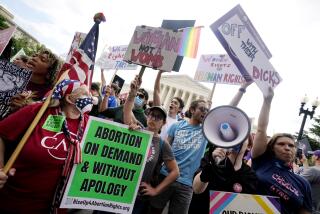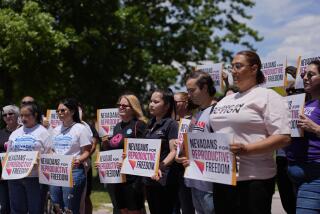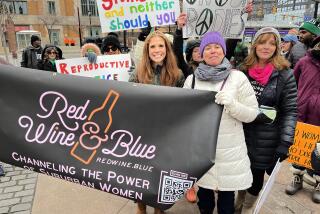Abortion Isn’t Just a Federal Issue
During the gubernatorial primary, some Californians seemed astonished that Gov. Gray Davis raised a woman’s right to choose safe, legal abortion as a campaign issue. Clearly, some California voters believe this is a federal matter and are not aware of the effect a state governor can have on a woman’s right to choose.
But Davis was correct to focus on the issue, and he must continue to do so during his general election campaign against Bill Simon, who is staunchly anti-choice.
Californians live in a state that sets the standard for protecting a woman’s right to family planning. Californians are overwhelmingly pro-choice. Where a candidate for state office stands on this issue can be a deal breaker.
While many people are familiar with the role of the U.S. Supreme Court in protecting choice, they may not be aware of just what kind of threats to reproductive freedom can--and do--exist at the state level.
Largely because of anti-choice measures introduced in states during the past six years, a woman’s reproductive rights today are more restricted than they were in 1973, when the Supreme Court handed down its Roe vs. Wade decision legalizing abortion.
In 2000 alone, 45 new anti-choice measures were adopted at the state level.
How can this be, given that Roe vs. Wade made a woman’s right to abortion “the law of the land”? For starters, an increasingly conservative U.S. Supreme Court has given states great leeway in restricting abortion.
In its 1989 decision in Webster vs. Reproductive Health Services, a majority of the court failed to reaffirm Roe vs. Wade’s “strict scrutiny” standard for reviewing abortion restrictions, meaning more restrictions could be passed into law. Many states set out to test what types of antiabortion restrictions the court would uphold.
Now, in 14 states, a woman may have to travel many miles to reach an abortion provider and then must wait 24 to 48 hours after seeing the doctor to actually have the procedure.
At least 25 states, plus the District of Columbia, limit public funding for abortion only to cases of life endangerment, rape and incest. In 2000, a total of 21 governors signed anti-choice legislation into state law.
Most important, if Roe vs. Wade were overturned, 11 states probably would pass a ban on abortion in all or most circumstances. With the U.S. Supreme Court one vote away from overturning Roe, the danger of this happening is real.
Clearly, states can wield tremendous power over a woman’s right to choose. In a striking example of this power, Davis, a Democrat, recently declared his support for state Senate Bill 1301. Among other things, the bill would codify Roe vs. Wade in the state, protecting California women’s right to choose regardless of what happens to Roe vs. Wade at the national level.
Meanwhile, GOP candidate Simon has declared his opposition to abortion and has stated that he does not want to discuss it during this last leg of the California gubernatorial campaign. Instead, he seeks to woo moderate GOP women back to the fold by focusing on education.
As governor, Simon would be able to appoint anti-choice judges to our state’s Supreme Court and to other state court positions, which would be problematic if Roe is overturned. And with veto and budget power, Simon would be able to put up dangerous roadblocks to a right that women in California have had for so long.
Davis, the media and the people of California must hold Simon’s feet to the fire on the issue of choice. And everyone should understand exactly why it is so critical to do so.
More to Read
Get the L.A. Times Politics newsletter
Deeply reported insights into legislation, politics and policy from Sacramento, Washington and beyond. In your inbox three times per week.
You may occasionally receive promotional content from the Los Angeles Times.










